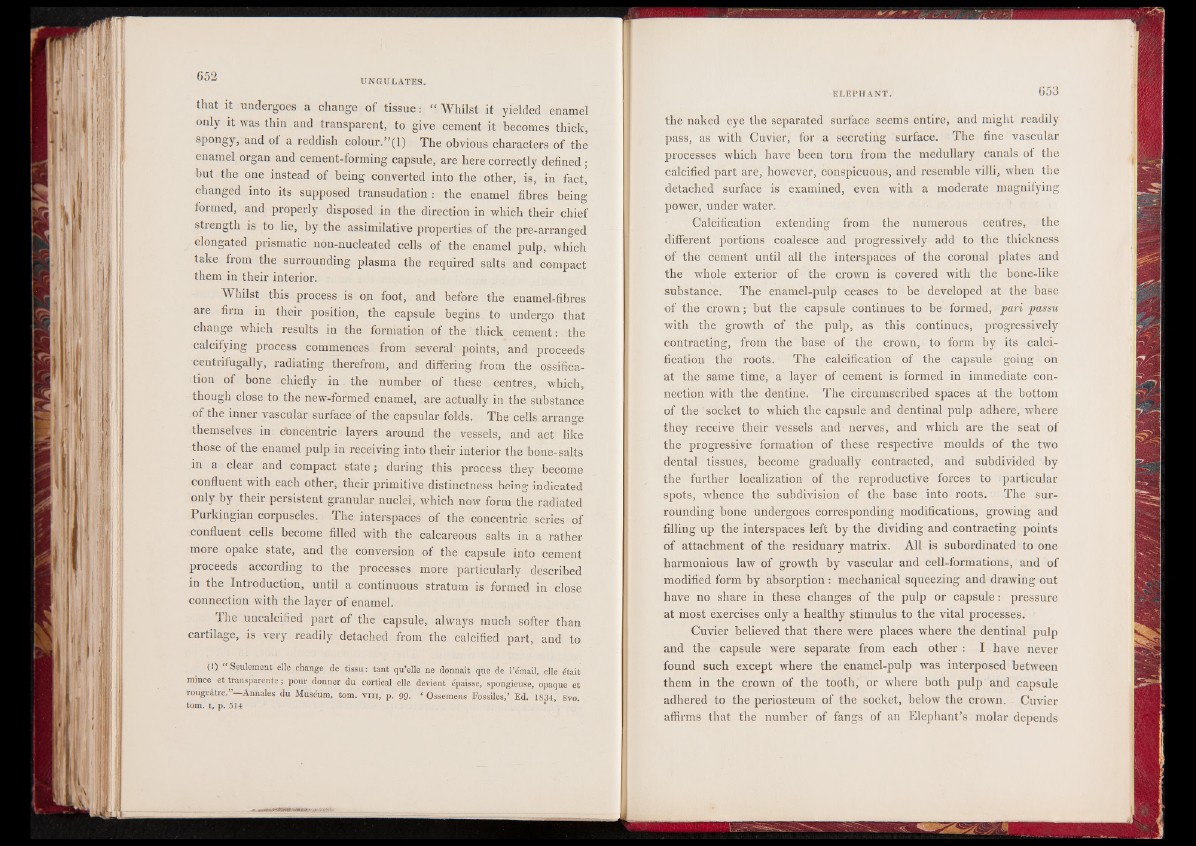
UNGULATES.
that it undergoes a change of tissue: “ Whilst it yielded enamel
only it was thin and transparent, to give cement it becomes thick,
spongy, and of a reddish colour.”(1) The obvious characters of the
enamel organ and cement-forming capsule, are here correctly defined ;
but the one instead of being converted into the other, is, in fact,
changed into its supposed transudation 1 the enamel fibres being
formed, and properly disposed in the direction in which their chief
strength is to lie, by the assimilative properties of the pre-arranged
elongated prismatic non-nucleated cells of the enamel pulp, which
take from the surrounding plasma the required salts and compact
them in their interior.
Whilst this process is on foot, and before the enamel-fibres
are firm in their position, the capsule begins to undergo that
change which results in the formation of the thick cement: the
calcifying process commences from several' points, and proceeds
centrifugally, radiating therefrom, and differing from the ossification
of bone chiefly in the number of these centres, which,
though close to the new-formed enamel, are actually in the substance
of the inner vascular surface of the capsular folds. The cells arrange
themselves in cbncentric layers around the vessels, and act like
those of the enamel pulp in receiving into their interior the bone-salts
in a clear and compact state; during this process they become
confluent with each other, their primitive distinctness being indicated
only by their persistent granular nuclei, which now form the radiated
Purkingian corpuscles. The interspaces of the concentric series of
confluent cells become filled with the calcareous salts in a rather
more opake state, and the conversion of the capsule into cement
proceeds according to the processes more particularly described
in the Introduction, until a continuous stratum is formed in close
connection with the layer of enamel.
The uncalcified part of the capsule, always much softer than
cartilage, is very readily detached from the calcified part, and to
(1) Seulement elle change de tissu: tant qu’elle ne donnait que de l’émail, elle était
mince et transparente ; pour donner du cortical elle devient épaisse, spongieuse, opaque et
rougeâtre.”—Annales du Muséum, tom. vin, p. 99. tom. I, p. 514 ‘ Ossemens Eossilesi’ Ed. 1834, 8vo.
ELEPHANT. 653
the naked eye the separated surface seems entire, and might readily
pass, as with Cuvier, for a secreting surface. The fine vascular
processes which have been torn from the medullary canals of the
calcified part are, however, conspicuous, and resemble villi, when the
detached surface is examined, even with a moderate magnifying
power, under water.
Calcification extending from the numerous centres, the
different portions coalesce and progressively add to the thickness
of the cement until all the interspaces of the coronal plates and
the whole exterior of the crown is covered with the bone-like
substance. The enamel-pulp ceases to be developed at the base
of the crown; but the capsule continues to be formed, pari passu
with the growth of the pulp, as this continues, progressively
contracting, from the base of the crown, to form by its calcification
the roots. The calcification of the capsule going on
at the same time, a layer of cement is formed in immediate connection
with the dentine. The circumscribed spaces at the bottom
of the socket to which the capsule and dentinal pulp adhere, where
they receive their vessels and nerves, and which are the seat of
the progressive formation of these respective moulds of the two
dental tissues, become gradually contracted, and subdivided by
the further localization of the reproductive forces to particular
spots, whence the subdivision of the base into roots. The surrounding
hone undergoes corresponding modifications, growing and
filling up the interspaces left by the dividing and contracting points
of attachment of the residuary matrix. All is subordinated to one
harmonious law of growth by vascular and cell-formations, and of
modified form by absorption : mechanical squeezing and drawing out
have no share in these changes of the pulp or capsule: pressure
at most exercises only a healthy stimulus to the vital processes.
Cuvier believed that there were places where the dentinal pulp
and the capsule were separate from each other : I have never
found such except where the enamel-pulp was interposed between
them in the crown of the tooth, or where both pulp and capsule
adhered to the periosteum of the socket, below the crown. Cuvier
affirms that the number of fangs of an Elephant’s molar depends